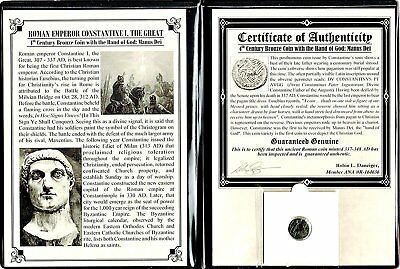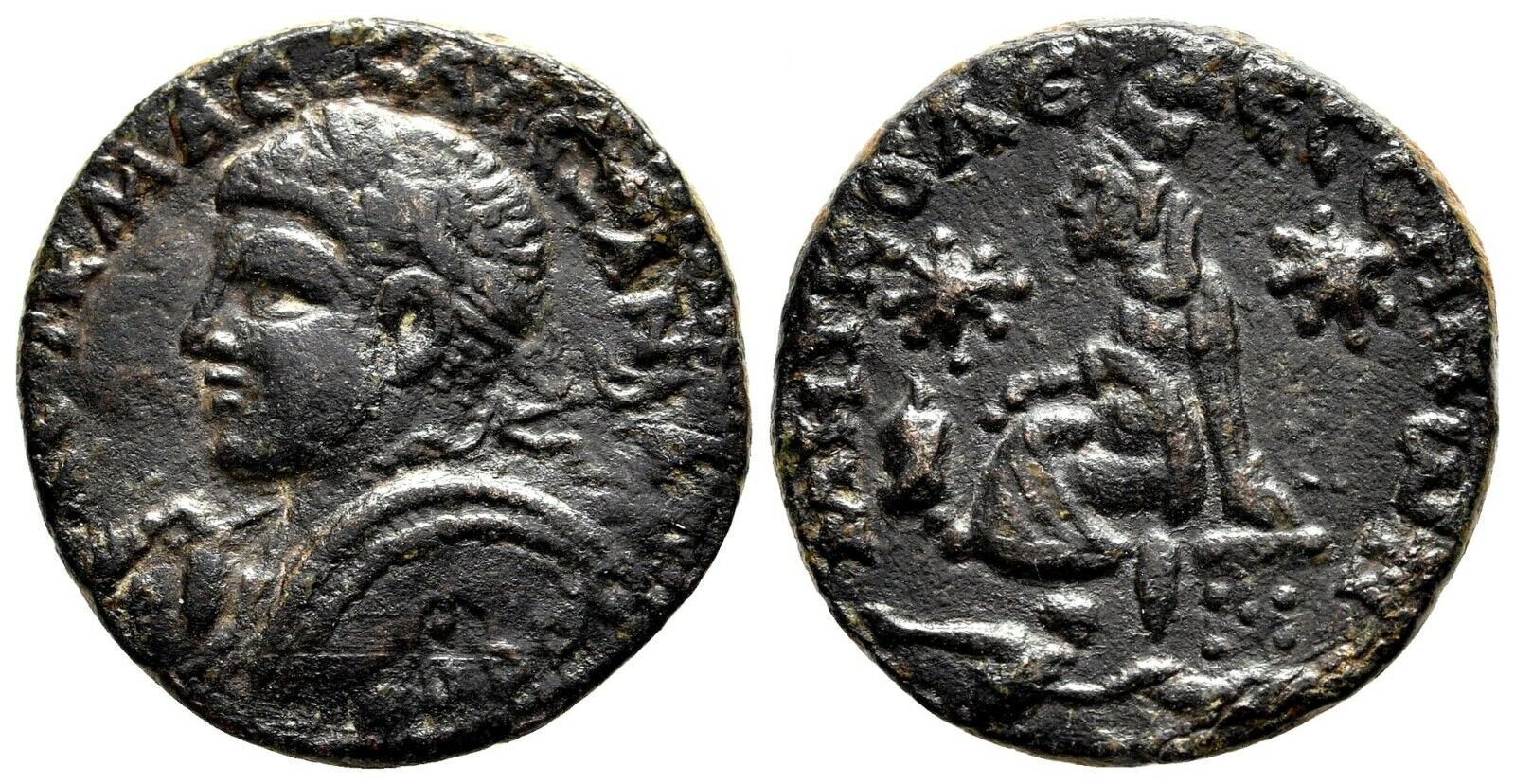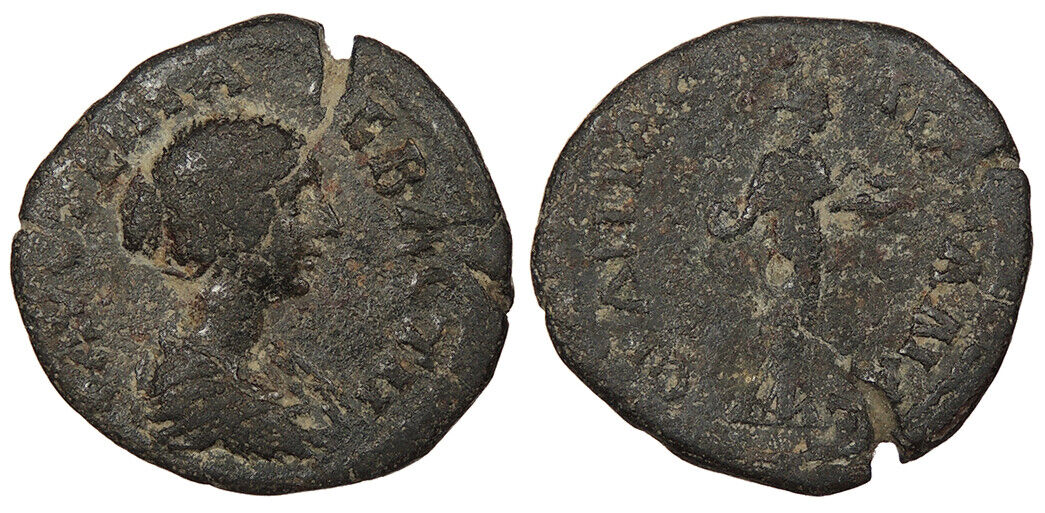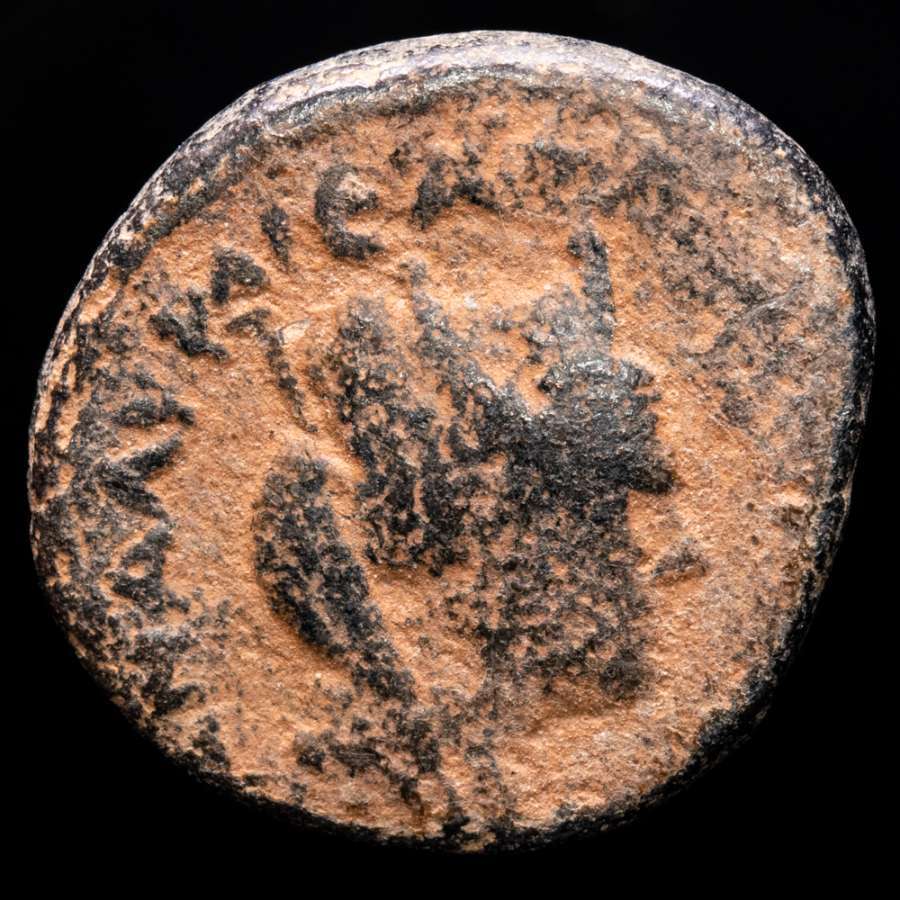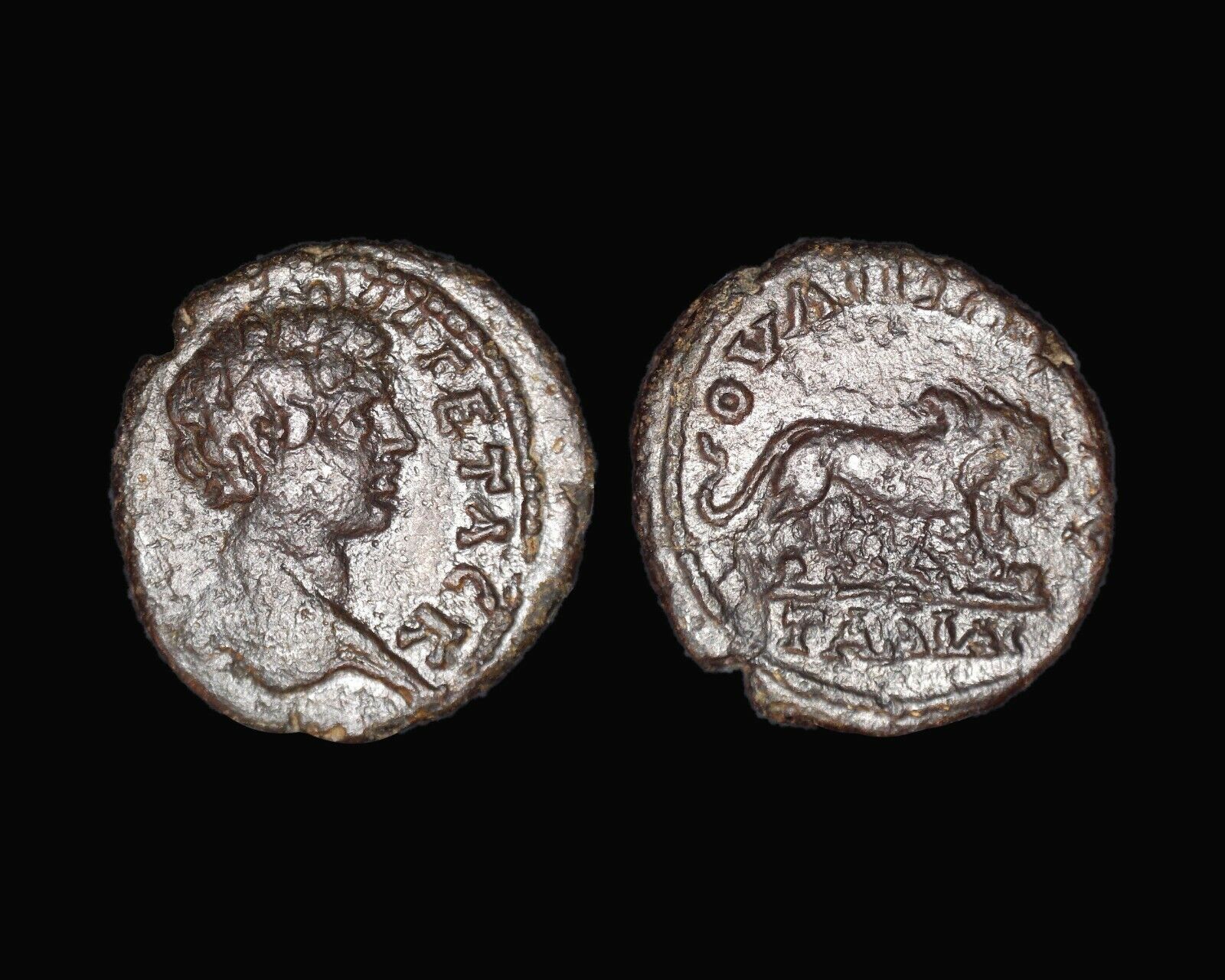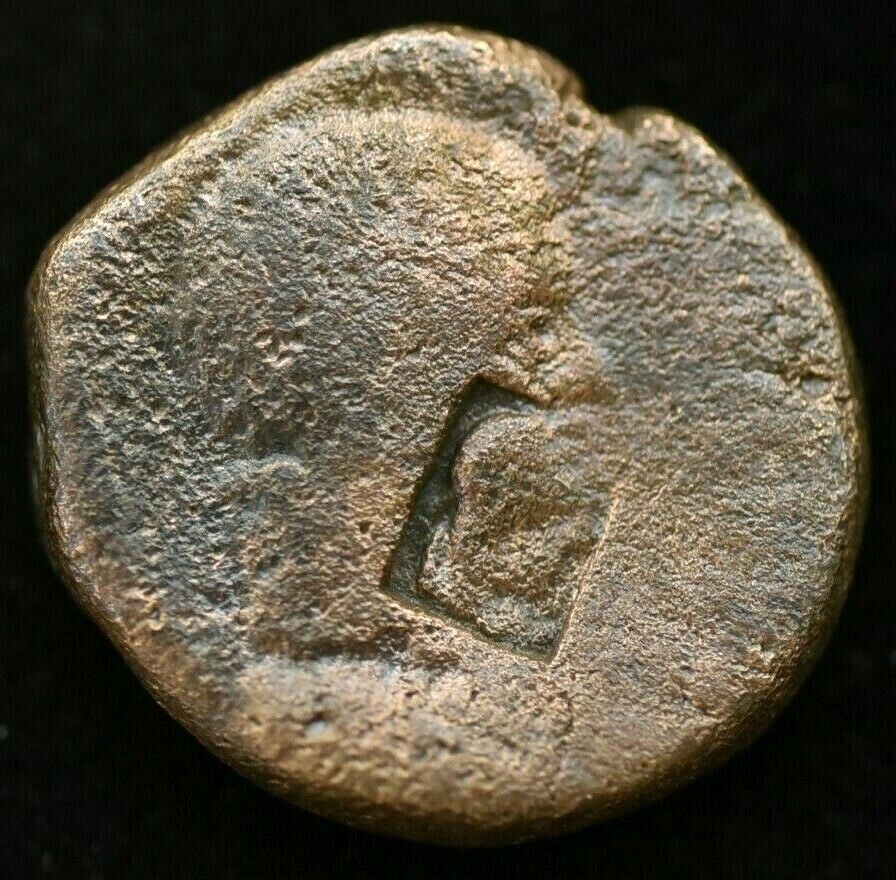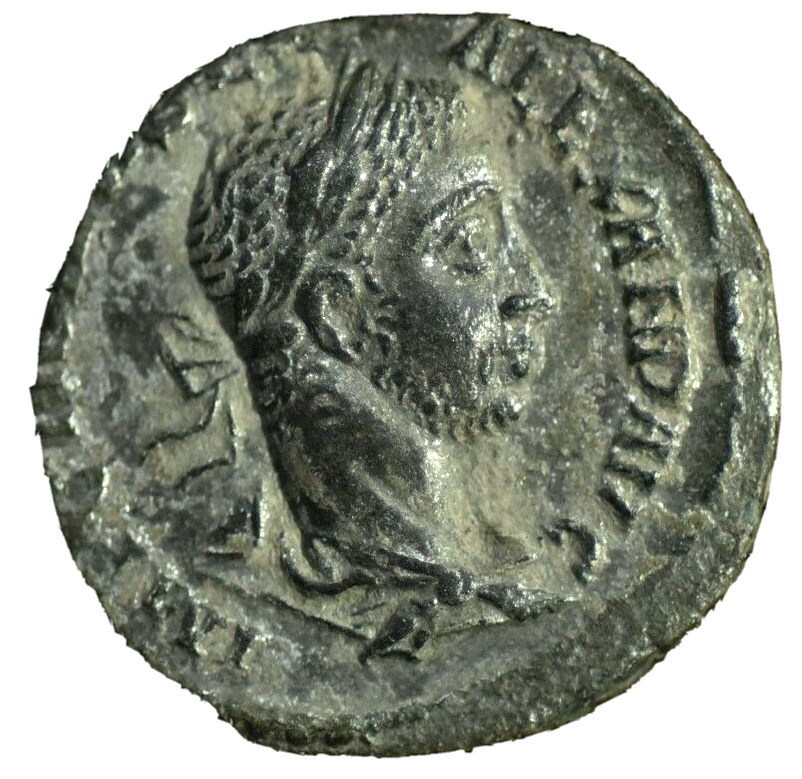-40%
JULIA MAMAEA 222AD Nicaea Bithynia Legionary Standards Ancient Roman Coin i79751
$ 62.72
- Description
- Size Guide
Description
Item:i79751
Authentic Ancient Coin of:
Julia Mamaea
-
Augusta
: 222-235 A.D.
Bronze 19mm (4.86 grams) of Nicaea in Bithynia circa 222-235 A.D.
Reference: BMC 105v; SNG Cop 521v (legend. breaks), SGI 3421
IOVLIA MAMAIA AVΓ, draped bust right.
NIKAIEΩN, three legionary standards.
You are bidding on the exact item pictured, provided with a Certificate of Authenticity and Lifetime Guarantee of Authenticity.
Standards
Roman military standards. The standards with discs, or
signa
(
first three on left
) belong to
centuriae
of the legion (the image does not show the heads of the standards - whether spear-head or wreathed-palm). Note (
second from right
) the legion's
aquila
. The standard on the extreme right probably portrays the She-wolf (
lupa
) which fed Romulus, the legendary founder of Rome. (This was the emblem of
Legio VI Ferrata
, a legion then based in Judaea, a detachment of which is known to have fought in Dacia). Detail from Trajan's Column, Rome
Modern reenactors parade with replicas of various legionary standards. From left to right:
signum
(spear-head type), with four discs;
signum
(wreathed-palm type), with six discs;
imago
of ruling emperor; legionary
aquila
;
vexillum
of commander (
legatus
) of
Legio XXX Ulpia Victrix
, with embroidered name and emblem (
Capricorn
) of legion
Each tactical unit in the imperial army, from
centuria
upwards, had its own standard. This consisted of a pole with a variety of adornments that was borne by dedicated standard-bearers who normally held the rank of
duplicarius
. Military standards had the practical use of communicating to unit members where the main body of the unit was situated, so that they would not be separated, in the same way that modern tour-group guides use umbrellas or flags. But military standards were also invested with a mystical quality, representing the divine spirit (
genius
) of the unit and were revered as such (soldiers frequently prayed before their standards). The loss of a unit's standard to the enemy was considered a terrible stain on the unit's honour, which could only be fully expunged by its recovery.
The standard of a
centuria
was known as a
signum
, which was borne by the unit's
signifer
. It consisted of a pole topped by either an open palm of a human hand or by a spear-head. The open palm, it has been suggested, originated as a symbol of the maniple (
manipulus
="handful"), the smallest tactical unit in the Roman army of the mid-Republic. The poles were adorned with two to six silver discs (the significance of which is uncertain). In addition, the pole would be adorned by a variety of cross-pieces (including, at bottom, a crescent-moon symbol and a tassel). The standard would also normally sport a cross-bar with tassels.
The standard of a Praetorian cohort or an auxiliary cohort or
ala
was known as a
vexillum
or banner. This was a square flag, normally red in colour, hanging from a crossbar on the top of the pole. Stitched on the flag would be the name of the unit and/or an image of a god. An exemplar found in Egypt bears an image of the goddess Victory on a red background. The
vexillum
was borne by a
vexillarius
. A legionary detachment (
vexillatio
) would also have its own
vexillum
. Finally, a
vexillum
traditionally marked the commander's position on the battlefield.
[194]
The exception to the red colour appears to have been the Praetorian Guard, whose
vexilla
, similar to their clothing, favoured a blue background.
From the time of Marius (consul 107 BC), the standard of all legions was the
aquila
("eagle"). The pole was surmounted by a sculpted eagle of solid gold, or at least gold-plated silver, carrying thunderbolts in its claws (representing Jupiter, the highest Roman god. Otherwise the pole was unadorned. No exemplar of a legionary eagle has ever been found (doubtless because any found in later centuries were melted down for their gold content). The eagle was borne by the
aquilifer
, the legion's most senior standard-bearer. So important were legionary eagles as symbols of Roman military prestige and power, that the imperial government would go to extraordinary lengths to recover those captured by the enemy. This would include launching full-scale invasions of the enemy's territory, sometimes decades after the eagles had been lost e.g. the expedition in 28 BC by Marcus Licinius Crassus against Genucla (Isaccea, near modern Tulcea, Rom., in the Danube delta region), a fortress of the Getae, to recover standards lost 33 years earlier by Gaius Antonius, an earlier proconsul of Macedonia. Or the campaigns of AD 14-17 to recover the three eagles lost by Varus in AD 6 in the Teutoburg Forest.
Under Augustus, it became the practice for legions to carry portraits (
imagines
) of the ruling emperor and his immediate family members. An
imago
was usually a bronze bust carried on top of a pole like a standard by an
imaginifer
.
From around the time of Hadrian (r. 117-38), some auxiliary
alae
adopted the dragon-standard (
draco
) commonly carried by Sarmatian cavalry squadrons. This was a long cloth wind-sock attached to an ornate sculpture of an open dragon's mouth. When the bearer (
draconarius
) was galloping, it would make a strong hissing-sound.
Decorations
The Roman army awarded a variety of individual decorations (
dona
) for valour to its legionaries.
Hasta pura
was a miniature spear;
phalerae
were large medal-like bronze or silver discs worn on the cuirass;
armillae
were bracelets worn on the wrist; and torques were worn round the neck, or on the cuirass. The highest awards were the
coronae
("crowns"), of which the most prestigious was the
corona civica
, a crown made oak-leaves awarded for saving the life of a fellow Roman citizen in battle. The most valuable award was the
corona muralis
, a crown made of gold awarded to the first man to scale an enemy rampart. This was awarded rarely, as such a man hardly ever survived.
There is no evidence that auxiliary common soldiers received individual decorations like legionaries, although auxiliary officers did. Instead, the whole regiment was honoured by a title reflecting the type of award e.g.
torquata
("awarded a torque") or
armillata
("awarded bracelets"). Some regiments would, in the course of time, accumulate a long list of titles and decorations e.g.
cohors I Brittonum Ulpia torquata pia fidelis c.R.
.
Julia Mamaea
-
Augusta
: 222-235 A.D.
| Mother of
Severus Alexander
| Daughter of
Julia Maesa
| Mother-in-law of
Orbiana
| Sister of
Julia Soaemias
| Nice of
Julia Domna
and
Septimius Severus
| Aunt of
Elagabalus
| Cousin of
Caracalla
and
Geta
|
Julia Avita Mamaea
(14 or 29 August after 180-235) was the second daughter of Julia Maesa, a powerful Roman woman of Syrian Arab origin and Syrian noble Julius Avitus. She was a niece of empress Julia Domna and emperor Septimius Severus and sister of Julia Soaemias. She was born and raised in Emesa (modern Homs, Syria).
Julia's first husband was a former consul (whose name is unknown) who died. Julia married as her second husband Syrian Promagistrate Marcus Julius Gessius Marcianus. Julia bore Marcianus two children, a daughter called Theoclia (little is known of her) and a son, Marcus Julius Gessius Bassianus Alexianus, later emperor Alexander Severus. Unlike her sister, Julia Mamaea was reported to be a virtuous woman, never involved in scandals.
As a member of the Imperial Roman family, she watched closely the death of her cousin Caracalla and the ascent to power of her nephew Elagabalus, the oldest grandson of Julia Maesa and her choice to the throne. Eventually Elagabalus and his mother Julia Soaemias proved incompetent rulers and favour fell on Alexander, Julia's son. He became emperor in 222, following Elagabalus' murder by the Praetorian Guard. Julia and her mother became regents in the name of Alexander, then 14 years old. Upon adulthood, Alexander confirmed his esteem for his mother and named her
consors imperii
(imperial consort). It was in this condition that she accompanied her son in his campaigns: a custom started with Julia Domna. Thus she travelled to the East, for the campaign against Parthia and to the Germania provinces. Julia Mamaea was with Alexander in Moguntiacum (modern Mainz), capital of Germania Superior, when he was assassinated by his troops. She suffered the same fate.
\
Frequently Asked Questions
Mr. Ilya Zlobin
, world-renowned expert numismatist, enthusiast, author and dealer in authentic ancient Greek, ancient Roman, ancient Byzantine, world coins & more.
Who am I dealing with?
You are dealing with Ilya Zlobin, ancient coin expert, enthusiast, author and dealer with an online store having a selection of over 15,000 items with great positive feedback from verified buyers and over 10 years experience dealing with over 57,000 ancient and world coins and artifacts. Ilya Zlobin is an independent individual who has a passion for coin collecting, research and understanding the importance of the historical context and significance all coins and objects represent. Most others are only concerned with selling you, Ilya Zlobin is most interested in educating you on the subject, and providing the largest selection, most professional presentation and service for the best long-term value for collectors worldwide creating returning patrons sharing in the passion of ancient and world coin collecting for a lifetime.
How long until my order is shipped?
Orders are shipped by the next business day (after receipt of payment) most of the time.
How will I know when the order was shipped?
After your order has shipped, you will be left positive feedback, and that date could be used as a basis of estimating an arrival date. Any tracking number would be found under your 'Purchase history' tab.
USPS First Class mail takes about 3-5 business days to arrive in the U.S. International shipping times cannot be estimated as they vary from country to country.
Standard international mail to many countries
does not
include a tracking number, and can also be slow sometimes.
For a tracking number and signature confirmation, you may want to do Express Mail International Shipping, which costs more, however, is the fastest and most secure. Additionally you may be able to receive your order in as little as 3-5 business days using this method. For Express Mail International, it may be possible to place up to 10-15 items in one package (for the one shipping cost) as it is flat rate envelope, which may be the most cost-effective, secure and fastest way to receive items internationally. Send me a message about this and I can update your invoice should you want this method.
Getting your order to you, quickly and securely is a top priority and is taken seriously here.
Great care is taken in packaging and mailing every item securely and quickly.
Please be aware, I cannot take responsibility for any postal service delivery delays, especially for international packages as it may happen in rare instances.
What is a certificate of authenticity and what guarantees do you give that the item is authentic?
Each of the items sold here, is provided with a Certificate of Authenticity, and a Lifetime Guarantee of Authenticity, issued by a world-renowned numismatic and antique expert that has identified over 57,000 ancient coins and has provided them with the same guarantee. You will be very happy with what you get with the COA; a professional presentation of the coin, with all of the relevant information and a picture of the coin you saw in the listing. Additionally, the coin is inside it's own protective coin flip (holder), with a 2x2 inch description of the coin matching the individual number on the COA.
On the free-market such a presentation alone, can be considered a - value all in itself, and it comes standard with your purchases from me,
FREE.
With every purchase, you are leveraging my many years of experience to get a more complete context and understanding of the piece of history you are getting. Whether your goal is to collect or give the item as a gift, coins presented like this could be more prized and valued higher than items that were not given such care and attention to.
Buy a coin today and own a piece of history, guaranteed.
Is there a money back guarantee?
I offer a 30 day unconditional money back guarantee. I stand behind my coins and would be willing to exchange your order for either store credit towards other coins, or refund, minus shipping expenses, within 30 days from the receipt of your order. My goal is to have the returning customers for a lifetime, and I am so sure in my coins, their authenticity, numismatic value and beauty, I can offer such a guarantee.
When should I leave feedback?
Once you receive your order, please leave a positive feedback. Please don't leave any negative feedbacks, as it happens sometimes that people rush to leave feedback before letting sufficient time for their order to arrive. Also, if you sent an email, make sure to check for my reply in your messages before claiming that you didn't receive a response. The matter of fact is that any issues can be resolved, as reputation is most important to me. My goal is to provide superior products and quality of service.
How and where do I learn more about collecting ancient coins?
Visit the "
Guide on How to Use My Store
" for on an overview about using my store, with additional information and links to all other parts of my store which may include educational information on topics you are looking for.



